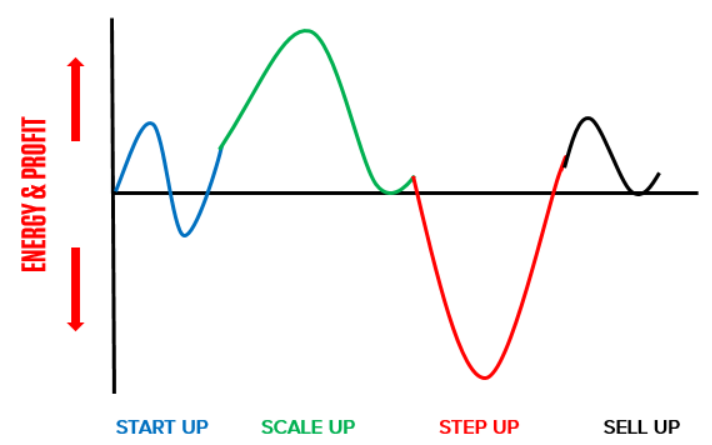London Calling
DATELINE: PARIS, FRANCE
Hi –
It won’t affect you in the slightest to know I arrived safely in London, and am today co-facilitating a workshop at the Ecole des Ponts Business School in Paris. The event is based on some of the contributions to my most recent best-selling, multi-author book Visionary Male Leaders.
- WhatsApp and Email are always the best way to reach me while I am abroad. Telegram and SMS work fine, but standard Voice Calls are tricky.
- Thanks for understanding if it takes me a few hours longer to reply.
Blackboard Fridays Episode #57 – The Top 3 Priorities for a Start Up Business
Every business moves through the same lifecycle. EVERY. Business.
Understanding the Business Lifecycle, as it applies to your business and where every one of your clients is situated, is a fundamental entrepreneurial skill.
So much so, that the business lifecycle sits atop ‘The Most Colourful Business Strategy in the World‘ and was the topic of #BlackboardFridays Episode 1 way back in 2016.
Over the next 4 weeks, we’re going to dive deeper into each of the four phases in the lifecycle: Start Up, Scale Up, Step Up, and Sell Up.
Wherever you are in your business, one of these will have immediate relevance. If your clients are also business owners or businesses, then watching each of these will help you better understand, service, and sell to your customers.
Start at the Very Beginning
We start this week with the excitement of new enterprise, and the Top 3 Priorities for a Start Up business. Watch the episode here.
I talk a lot about The Business Lifecycle. Because it’s critical, for you as a business owner to know:
- Where your business is on the journey
- Where you are personally on the journey (as it may be different to the business, often a little way ahead)
- Where each of your team members are on their personal journey through your business, and
- (If you’re a B2B company) Where your customers and potential customers are on their business lifecycle.
Before I get too far into today’s topic, let me be clear about that last point: If you’re a B2B company selling into other businesses, then understanding where your customers and potential customers are on their business lifecycle gives you an opportunity to communicate with them much more clearly, speak to their motivation much better, and create greater conversion rates.
Understanding all of the aspects of the business lifecycle gives you a competitive advantage. So, for now and across this and the next three episodes, I’m going to go deeper into each of the four aspects of the business lifecycle: Start Up, Scale Up, Step Up, and Sell Up.
You may already know exactly where your business is, but be sure to watch all 4 to help you better understand how you can apply this strategic framework to yourself, to your business, to your team, and to your clients to create better business outcomes – wherever they may be located.
The Start Up Phase of Business
Starting today at Start Up.
I want you to think back to “Day One”. Do you remember the day that your business began?
A majority of business owners I talk to can actually still name the date even if it was 15 or 25 years ago when they began their business.
Do you remember how you felt on that day? The word I hear most often is excited.
I remember the first day I started my business, and I was excited too. Now, sometimes that excitement lasts for months. Sometimes it lasts for just a matter of minutes. But that Start Up phase of the business lifecycle is defined by me as the journey from that initial excitement through the joy and then into a beyond the trough of sorrow.
The excitement and joy is natural, and understandable. It’s the enthusiasm of having your own business, of starting this new venture, even if it’s not your first business.
Slowly, however, some of that joy dissipates. That frantic energy of the early months (or years) fades away. You find yourself in the trough of sorrow, in a state of anxiety or uncertainty of trying to determine whether or not this business is actually going to be viable.
Now, that initial energy is fantastic. It gets you going. You need it to get out of the bed in the morning in those early days of the business when there’s a whole lot of wheelspin going on. Similarly, you want to make sure you’re putting in place the necessary things to get through that trough of sorrow as quickly as possible.
I’ve talked before about the business lifecycle being a journey of speed bumps, hurdles, and brick walls. Speed bumps aren’t that hard to get over, but you need to have some momentum. As a business, it’s exactly the same. To shift out of Start Up and into Scale Up, to shift your energy from that excitement and that sorrow uncertainty into confidence that this business is going to work, you need to put in place three key priorities to generate revenue.

The reason we colour the Start Up phase in blue, is because it’s the Revenue Phase of a business. It is the phase where it is most critical that you developed revenue strategy and systems for your business.
The three priorities to help you to achieve that are…
1. Product-Market Fit
The number one priority for a Start Up business is to find a clear Product Market Fit.
It’s no good just building a product that you love, if there isn’t a target market for it. That’s what I call “a solution in search of a problem”.
What you need to do is:
- identify a target market
- understand their pain, their problems, and
- articulate how your solution, your product can help to those clients address their pain.
Getting to a clear Product Market Fit is normally an iterative process, as you test and refine both aspects – your product and how you position it in the market. Continually doing this back-and-forth conversation with customers can help you to sell much more sustainably.
2. Business Model
Start Up business Priority #2 is a Business Model.
You need to have a process in place so that you can:
- take on a client,
- service that client,
- deliver to their expectations, and
- do so in a systemized way that is, at the very least, almost profitable.
There’s a saying in tech startups that you need to “do things that don’t scale”.
Sometimes for your business model you need to do things that you’re not going to be able to do forever, just to prove that the product suits the market and that your business model can work.
3. Sustainable Marketing and Sales
Number three is Sustainable Marketing and Sales. Can you generate new clients and new customers for your business in a sustainable way?
I see a lot of Start Up phase businesses who don’t want to do sales and they think that their product is going to be so incredible, so successful that people are going to beat a path to their door. Unfortunately, that’s not the reality of business.
Sales isn’t a dirty word, particularly, if you apply the Gratitude Sales Model. “Thank you, thank you, thank you”.
Sales is about recognizing the value that you’re delivering, and the value that your customers are receiving. It’s building that machine so that every month, you can come in, you can put a dollar in the top of the machine, pull the business model lever, the sales process flows, and a dollar+ comes out at the bottom.
Summary
If you can build those three things:
- a clear product that has a clear market it fits into,
- the business model to deliver that product profitably, and
- the sustainable sales to keep your business fed,
that will give you revenue and that will give you the momentum you need to get through that speed bump.
Bonus Point: If You Sell to Start Ups
If you’re selling into Start Up businesses, understand the emotional journey that they’re going on, especially if they haven’t got all three of those priorities right.
Maybe they’re feeling excited and joyful in the really early stages. Maybe some of that sorrow or anxiety is starting to kick in?
Take the time to understand where in those steps they are, so that you can understand how best to help them with what they need to do for their business: shift into the confidence of a Scale Up.
Next Steps
Want to learn more about how this can apply to your business? It costs nothing to chat:
- Email me jacob@jacobaldridge.com (I read them all)
- Call, Text, or WhatsApp me +61 427 151 181
- Or just Subscribe https://jacobaldridge.com/about/subscribe-to-jacob-aldridge-com/ to stay in touch
With love,
Jacob Aldridge
International Business Advisor
Seriously international. Look at that map. I’m even going to France!
WhatsApp +61 427 151 181
Visit my website
Connect on LinkedIn




